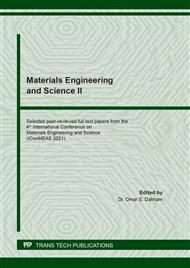[1]
M. Ouchi, M. Hibino, H. Okamura, Effect of superplasticizer on self-compactability of fresh concrete, Transp. resh. rec. 1574.1 (1997) 37-40.
DOI: 10.3141/1574-05
Google Scholar
[2]
S.D. Hwang, K.H. Khayat, O. Bonneau, Performance-based specifications of self-consolidating concrete used in structural applications. ACI Materials j. 103.2 (2006) 121.
DOI: 10.14359/15263
Google Scholar
[3]
M. Tabatabaeian, A. Khaloo, A. Joshaghani, E. Hajibandeh, Experimental investigation on effects of hybrid fibers on rheological, mechanical, and durability properties of high-strength SCC, Const. and Build. Mats. 147 (2017) 497-509.
DOI: 10.1016/j.conbuildmat.2017.04.181
Google Scholar
[4]
M. Sahmaran, I. Yaman, Hybrid fiber reinforced self-compacting concrete with a high-volume coarse fly ash, Const. and Build. Mat. 21.1 (2007) 150-156.
DOI: 10.1016/j.conbuildmat.2005.06.032
Google Scholar
[5]
K. Liew, A. Akbar, The recent progress of recycled steel fiber reinforced concrete, Const. and Build. Mats. 232 (2020) 117232.
DOI: 10.1016/j.conbuildmat.2019.117232
Google Scholar
[6]
C. Papakonstantinou, M.J. Tobolski, Use of waste tire steel beads in Portland cement concrete, Cem. and Conc. Res. 36 (2006) 1686-1691.
DOI: 10.1016/j.cemconres.2006.05.015
Google Scholar
[7]
M. A. Köroğlu, Behavior of composite self-compacting concrete (SCC) reinforced with steel wires from waste tires. J. of Const. 17(2008) 484-498.
DOI: 10.7764/rdlc.17.3.484
Google Scholar
[8]
K. Najim, A. Saeb, Z. Al-Azzawi, Structural behaviour and fracture energy of recycled steel fibre self-compacting reinforced concrete beams. J. of Buildg. Eng. 17(2018) 174-182.
DOI: 10.1016/j.jobe.2018.02.014
Google Scholar
[9]
H. Bensaci, B. Menadi, S. Kenai, Comparison of some fresh and hardened properties of self-consolidating concrete composites containing rubber and steel fibers recovered from waste tires. Nano Hybd. and Comp. 24 (2019). Trans Tech Publ.
DOI: 10.4028/www.scientific.net/nhc.24.8
Google Scholar
[10]
M. Mastali, A. Dalvand, Use of silica fume and recycled steel fibers in self-compacting concrete (SCC). Const. and Build. Mats. 125(2016) 196-209.
DOI: 10.1016/j.conbuildmat.2016.08.046
Google Scholar
[11]
Iraqi Standard Specification, No.5, Standard Portland Cement, Central Agency for Standardization and Quality Control, Baghdad, Iraq, (1984).
Google Scholar
[12]
Iraqi Standard Specification No.45, Aggregate from natural Sources for concrete and building constructions, Central Agency for Standardization and Quality Control, Baghdad, Iraq, (1984).
Google Scholar
[13]
ASTM C1240-05, Standard specification for silica fume used in cementitious mixtures, ASTM International, PA, (2011).
Google Scholar
[14]
ASTM C494-05, Standard specification for chemical admixtures for concrete, ASTM International, West Conshohocken, PA, (2005).
Google Scholar
[15]
ASTM C192-14, Standard practice for making and curing concrete test specimens in the laboratory, ASTM International, West Conshohocken, PA, (2014).
Google Scholar
[16]
The European guidelines for self-compacting concrete. BIBM, May (2005).
Google Scholar
[17]
ASTM C642-13, Standard Test method for density, absorption, and voids in hardened concrete, ASTM International, West Conshohocken, PA, (2013).
Google Scholar
[18]
BS. Testing hardened concrete. Compressive strength of test specimens, British Standards EN. (2009).
Google Scholar
[19]
ASTM C496-14, Standard test method for splitting tensile strength of cylindrical concrete specimens, ASTM International, West Conshohocken, PA, (2014).
Google Scholar
[20]
ASTM C597-16 Standard test method for pulse velocity through concrete. 2009, ASTM International West Conshohocken, PA, (2016).
Google Scholar
[21]
ASTM C1018-97, Standard Test Method for Flexural Toughness and First-Crack Strength of Fiber-Reinforced Concrete (Using Beam With Third-Point Loading), ASTM International West Conshohocken, PA, (1997).
DOI: 10.1520/c1018
Google Scholar
[22]
A. El-Dieb, M. Taha, Flow characteristics and acceptance criteria of fiber-reinforced self-compacted concrete. Const. and Build. Mats. 27(2012) 196-209.
DOI: 10.1016/j.conbuildmat.2011.07.004
Google Scholar
[23]
S. Grünewald, J. Walraven, Parameter-study on the influence of steel fibers and coarse aggregate content on the fresh properties of self-compacting concrete. Cem. and Conc. Res. 31(2001) 1793-1798.
DOI: 10.1016/s0008-8846(01)00555-5
Google Scholar
[24]
I. Irki, F. Debieb, E-H. Kadri, Effect of the length and the volume fraction of wavy steel fibers on the behavior of self-compacting concrete. J. of adh. Sci. and Tech. 31(2017) 735-748.
DOI: 10.1080/01694243.2016.1231394
Google Scholar
[25]
A. Bazgir, The behaviour of steel fibre reinforced concrete material and its effect on impact resistance of slabs, Doctoral dissertation. City University London (2016).
Google Scholar
[26]
O. Gencel, W. Brostow, T. Datashvili, M. Thedford, Workability and mechanical performance of steel fiber-reinforced self-compacting concrete with fly ash. Comp. Int. 18.2(2011) 169-184.
DOI: 10.1163/092764411x567567
Google Scholar
[27]
S.K. Mezzal, Z. Al-Azzawi, K.B. Najim, Effect of Discarded Steel Fibers on Impact Resistance, Flexural Toughness and Fracture Energy of High-Strength Self-Compacting Concrete Exposed to Elevated Temperatures. Fire Safety J. (2020) 103271.
DOI: 10.1016/j.firesaf.2020.103271
Google Scholar
[28]
R. Solis-Carcaño, E.I. Moreno, Evaluation of concrete made with crushed limestone aggregate based on ultrasonic pulse velocity. Cons. and Build. Mats. 22.6(2008) 1225-1231.
DOI: 10.1016/j.conbuildmat.2007.01.014
Google Scholar
[29]
D. Rambo, F. Silva, and R. Toledo Filho, Flexural behavior of hybrid steel fiber reinforced self-consolidating concretes. Rem: Revista Escola de Minas 67 (2014)27-32.
DOI: 10.1590/s0370-44672014000100004
Google Scholar


